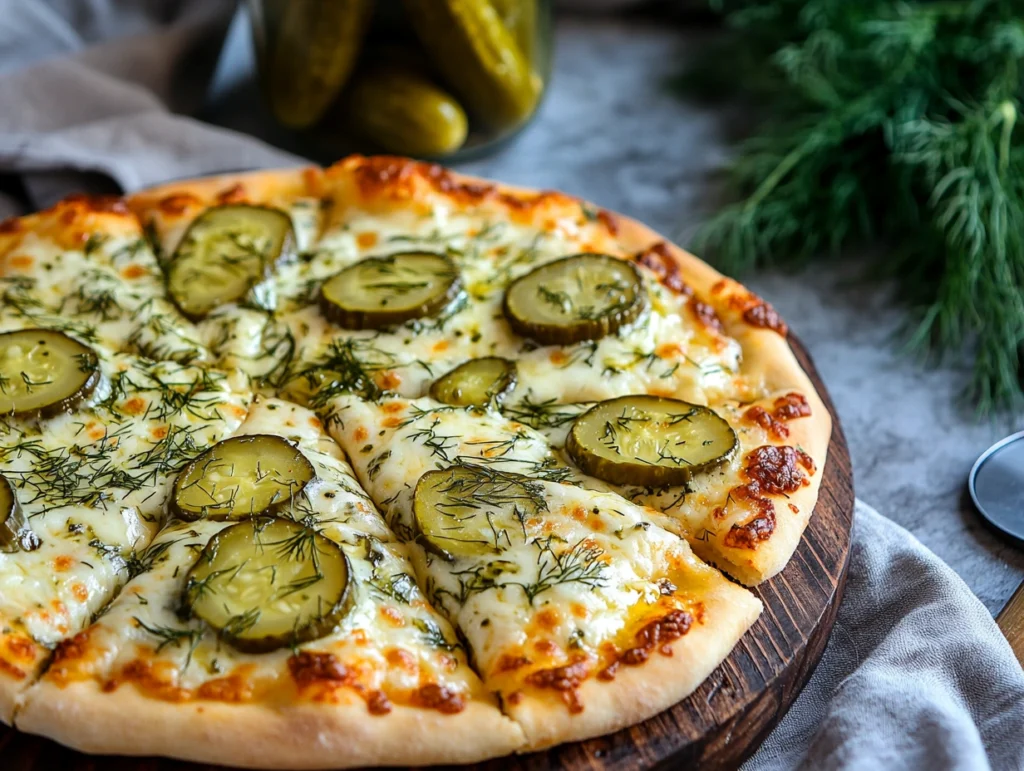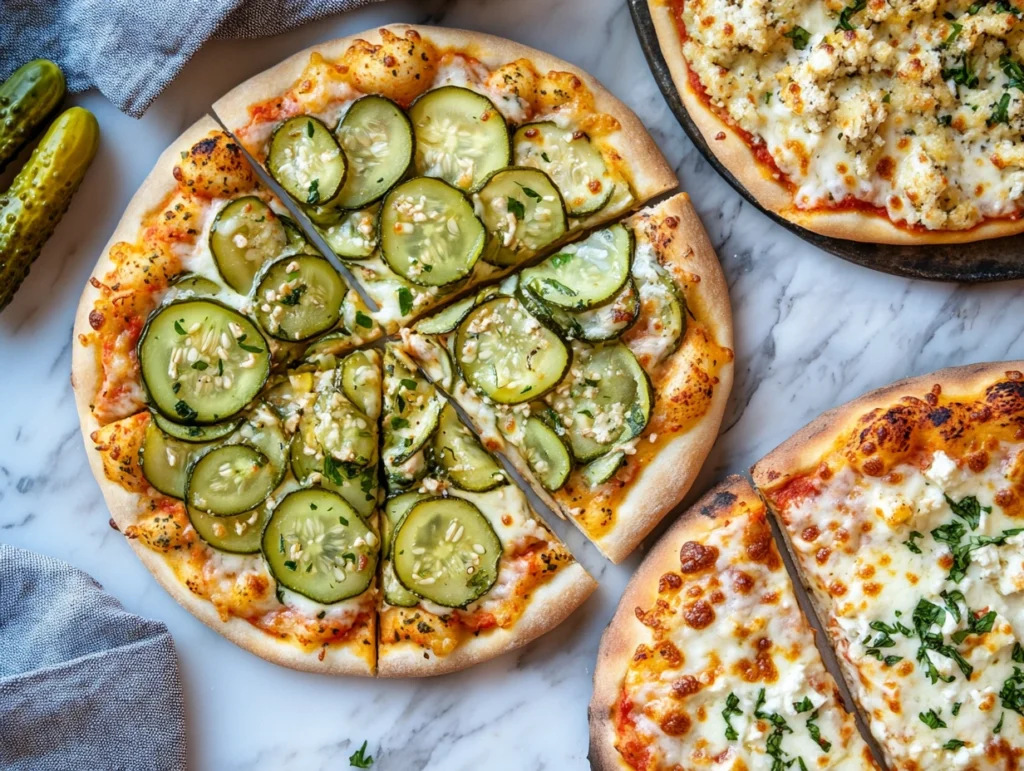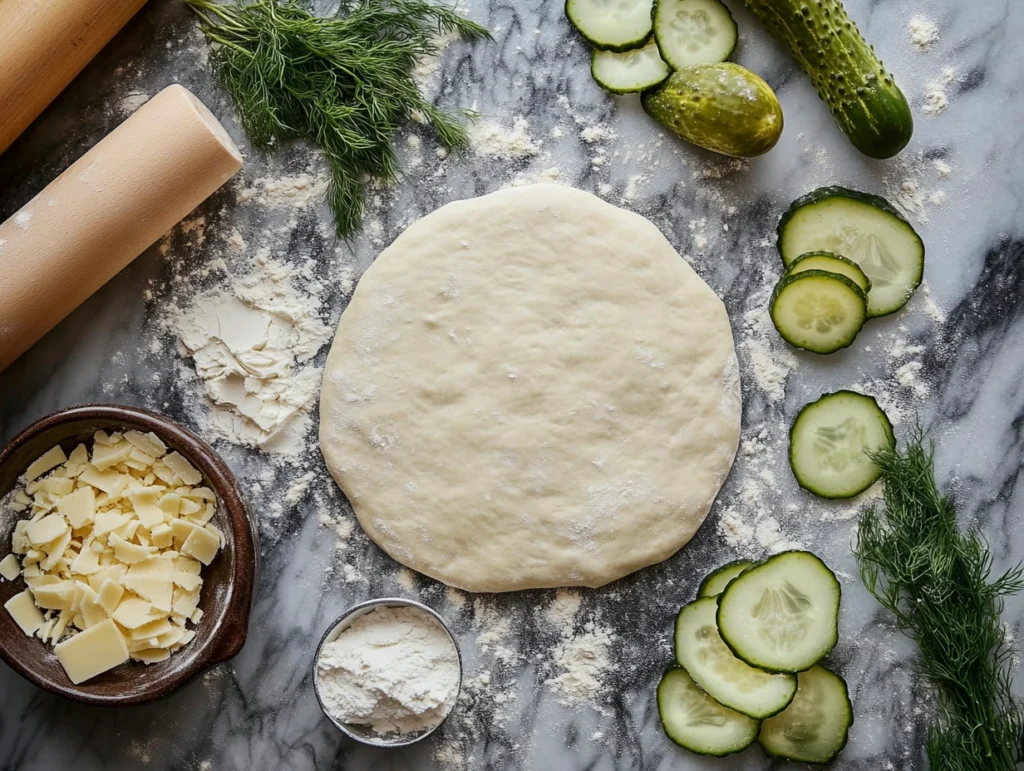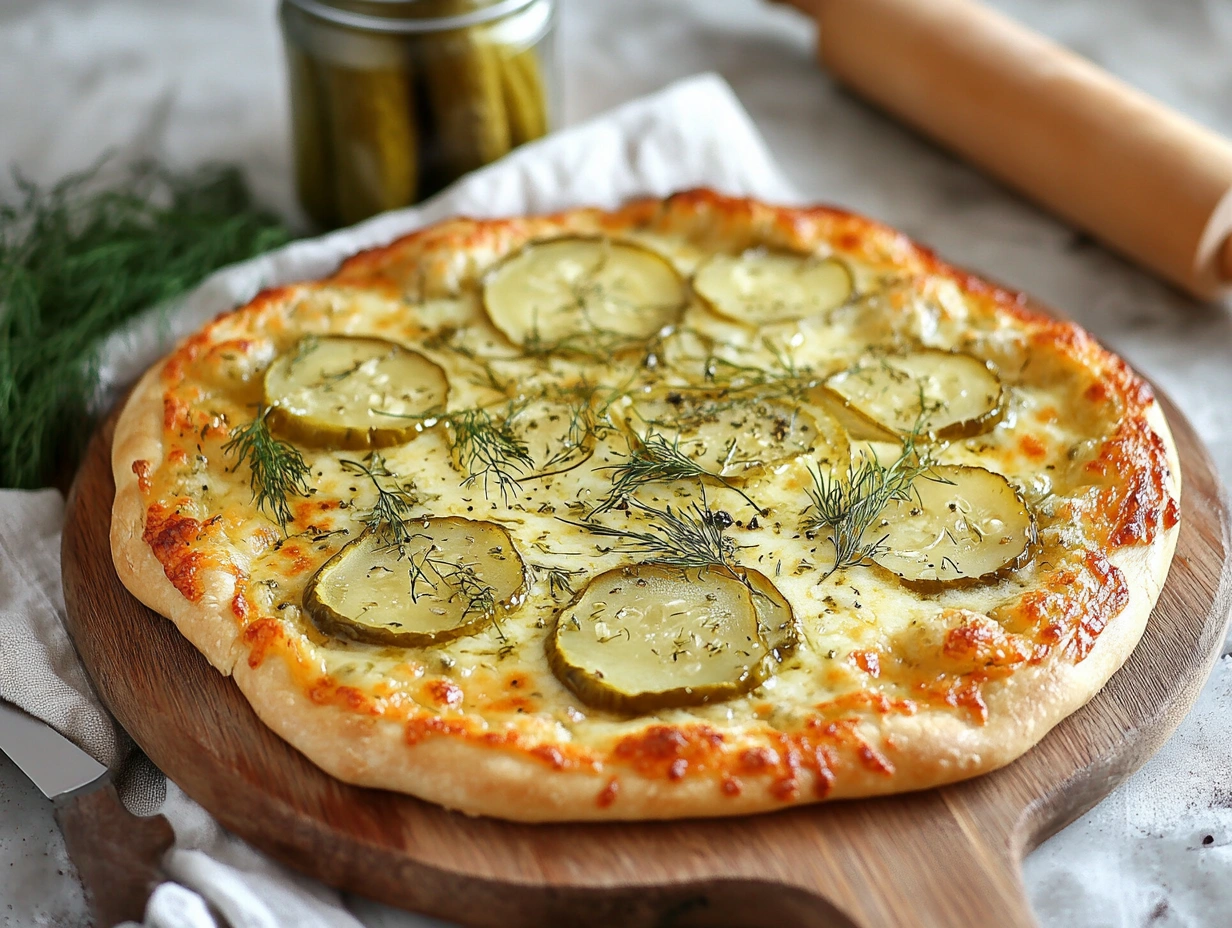1. Introduction
Pickle pie pizza might sound unconventional, but this creative dish has quickly captured the hearts (and taste buds) of adventurous foodies. Combining the tangy zing of pickles with the comforting flavors of pizza, it’s a culinary experience unlike any other. Whether you’re a pickle enthusiast or a pizza lover looking for a twist, this fusion delivers a taste explosion.

Alt Text: Tangy pickle pie pizza topped with fresh dill and cheese on a rustic wooden board.
In recent years, pickle pie pizza has risen in popularity thanks to its unique flavor profile and its viral success on social media. From local pizzerias experimenting with the concept to at-home chefs perfecting recipes, pickle pizza is now a trendy, must-try dish. This article dives deep into everything you need to know about pickle pie pizza, from its origins and variations to where you can find it or how to make your own.
2. History and Origins of Pickle Pizza
2.1. Early Beginnings
Pickles have been a beloved ingredient for centuries, often used as a tangy complement in various dishes. However, incorporating pickles into pizza didn’t become a trend until relatively recently. The idea is believed to have emerged in small artisanal pizzerias, where chefs experimented with bold flavors to surprise their customers.
The unique combination likely took root in regions where pickling and pizza culture already thrived. By pairing crispy crusts with creamy sauces and the sharpness of pickles, this innovation carved out its niche in the culinary world.
2.2. Regional Variations
As the concept of pickle pizza spread, different regions began to add their spin. In the Midwest, for instance, it’s common to see dill pickles layered over ranch dressing as a base sauce. Meanwhile, in coastal areas, chefs might incorporate spicy pickles or even sweet pickles to create a more nuanced flavor.
Each variation showcases local ingredients, further solidifying pickle pie pizza as a dish that can adapt to various tastes while maintaining its core identity.
2.3. Cultural Impact
Social media platforms have played a massive role in propelling pickle pizza to fame. Viral videos, Instagram posts, and even TikTok challenges have made the dish a household name. Its quirky appeal, combined with its surprisingly satisfying taste, has led to a cult following.
Continuing with the next two sections: What Does Pickle Pizza Taste Like? and Ingredients and Preparation.
3. What Does Pickle Pizza Taste Like?
3.1. Flavor Profile
Pickle pizza is a delightful mix of contrasting yet harmonious flavors. The tanginess of pickles is front and center, offering a zesty kick that balances beautifully with the creamy, cheesy base of the pizza. The crust provides a subtle, neutral canvas, while the toppings—such as fresh dill or garlic—add aromatic depth.
For many, the taste is a surprising blend of familiar comfort and exciting novelty. The pickles’ acidity cuts through the richness of the cheese, creating a refreshing bite that keeps you coming back for more.
3.2. Texture and Mouthfeel
The textures in a slice of pickle pizza are as intriguing as its flavors. The crust is typically crisp, while the cheese layer is gooey and melty. Pickles, whether sliced thinly or cut into chunks, retain their signature crunch, adding an unexpected texture that contrasts with the soft components of the pizza.
3.3. Comparison with Traditional Pizzas
While traditional pizzas rely on tomato sauce and savory toppings, pickle pizza takes a completely different approach. It’s less sweet than a classic margherita and often more acidic than a pepperoni pizza. Fans describe it as a perfect choice for those seeking a bold departure from standard pizza offerings.
4. Ingredients and Preparation
4.1. Essential Components
Creating the perfect pickle pizza requires balancing foundational pizza elements with the unique tang of pickles. Here are the key ingredients:
- Dough: A standard pizza dough works well, but a thin crust enhances the pickle’s flavors.
- Sauce Options: Ranch dressing is a popular choice, but garlic cream sauce or even a dill-infused base can elevate the dish.
- Cheese Selection: Mozzarella is a staple, but adding cheddar or provolone can deepen the flavor.
- Pickle Varieties: Dill pickles are the most common choice, though spicy or bread-and-butter pickles can add variety.
4.2. Step-by-Step Recipe Guide
- Prepare the Dough: Roll out pizza dough to your preferred thickness.
- Spread the Sauce: Apply a thin layer of ranch or garlic cream sauce evenly across the surface.
- Add Cheese: Generously sprinkle shredded mozzarella over the sauce.
- Top with Pickles: Arrange pickle slices or chunks evenly across the pizza.
- Bake: Place in a preheated oven at 450°F (232°C) and bake for 12-15 minutes, or until the crust is golden brown.
- Garnish: Add fresh dill, a drizzle of olive oil, or a sprinkle of red pepper flakes before serving.
4.3. Tips for Perfecting the Recipe
- Use High-Quality Pickles: Opt for fresh, crunchy pickles to avoid sogginess.
- Drain Excess Liquid: Pat pickles dry before placing them on the pizza to prevent a soggy crust.
- Experiment with Cheeses: Mixing cheeses can create a more complex flavor profile.
5. Variations and Customizations
5.1. Spicy Pickle Pizza
For spice lovers, pickle pizza can easily take on a fiery twist. Swap regular dill pickles for spicy pickles or jalapeño-infused varieties. Add red pepper flakes or drizzle sriracha over the pizza for extra heat. The combination of spice and tang creates a bold flavor experience.

Alt Text: Three pickle pizza variations: spicy, sweet, and vegan options.
5.2. Sweet and Savory Combinations
To cater to those who enjoy contrasting flavors, consider incorporating sweet pickles alongside savory toppings like bacon or smoked sausage. A honey drizzle over the finished pizza adds a surprising sweetness that balances the tangy pickles and rich cheese.
5.3. Vegan and Gluten-Free Options
Pickle pizza can be tailored for dietary restrictions without compromising on taste:
- Vegan: Use plant-based cheese and a dairy-free ranch or garlic sauce. Vegan pickles are naturally compatible.
- Gluten-Free: Replace regular dough with a gluten-free pizza crust. Ensure that all other ingredients are certified gluten-free.
These variations allow everyone to enjoy pickle pizza, making it versatile for any crowd or occasion.
6. Serving Suggestions and Pairings
6.1. Complementary Side Dishes
Pickle pizza pairs wonderfully with sides that echo its tangy, creamy flavors. Popular options include:
- Pickle Fries: Crispy fried pickle spears with a side of ranch dipping sauce.
- Coleslaw: A light and creamy coleslaw adds a refreshing crunch.
- Loaded Potato Skins: These rich and savory bites complement the pizza’s bold flavors.
6.2. Beverage Pairings
To enhance the dining experience, serve pickle pizza with beverages that balance its flavors:
- Beer: A light lager or wheat beer pairs well with the pizza’s acidity.
- Cocktails: A dill-infused vodka martini or a pickleback shot makes a fun addition.
- Non-Alcoholic Options: Sparkling lemonade or a cucumber-infused soda offers a refreshing, tangy accompaniment.
6.3. Presentation Ideas
A beautifully presented pickle pizza elevates its appeal:
- Serve it on a rustic wooden board for a casual vibe.
- Add fresh herbs like dill or parsley as a garnish for a pop of color.
- Slice the pizza into small squares or wedges for easy sharing at parties.
7. Nutritional Analysis
7.1. Caloric Content
Pickle pizza, like other specialty pizzas, can vary in calories depending on the ingredients. A single slice typically contains around 200–300 calories, with higher values if additional toppings like bacon or extra cheese are included.
7.2. Macronutrient Breakdown
The typical macronutrient composition per slice (based on a standard 8-slice pizza):
- Carbohydrates: 25–30 grams
- Protein: 8–12 grams
- Fat: 10–15 grams These values can be adjusted by using alternative ingredients such as low-fat cheese or gluten-free crust.
7.3. Health Considerations
While pickle pizza may not be considered a low-calorie option, its unique flavor makes it worth an occasional indulgence. To make it healthier:
- Opt for whole-grain crusts to add fiber.
- Use reduced-fat cheese to lower fat content.
- Select pickles with no added sugars or artificial preservatives.
Nutritional Table:
| Nutrient | Amount Per Slice (Approx.) | % Daily Value* |
|---|---|---|
| Calories | 250 | 12% |
| Carbohydrates | 28g | 10% |
| Protein | 10g | 20% |
| Total Fat | 12g | 18% |
| Saturated Fat | 5g | 25% |
| Sodium | 850mg | 37% |
| Fiber | 2g | 8% |
*Percent Daily Values are based on a 2,000-calorie diet.
8. Where to Find Pickle Pizza
8.1. Popular Restaurants Offering Pickle Pizza
Pickle pizza has made its way onto menus at innovative restaurants across the U.S. Some popular spots include:
- QC Pizza (Minnesota): Known for their famous “Keto Dill Pickle Bacon Cheeseburger Pizza.”
- Strange Brew Pub (Connecticut): A hotspot for adventurous pizza flavors.
- Local Artisanal Pizzerias: Many boutique pizzerias have added their version of pickle pizza to cater to foodies.
8.2. Availability in Different Regions
- Midwest: The heart of the pickle pizza trend, with many regional adaptations.
- Northeast: Home to quirky pizza shops experimenting with the trend.
- Southern States: Known for incorporating spicy or bread-and-butter pickles for a twist.
8.3. Does Domino’s Have Pickle Pizza?
As of now, Domino’s does not officially offer pickle pizza on its menu. However, some creative customers have modified their orders to include pickles as a topping, using the chain’s customization options. Keep an eye out for potential menu changes as the trend grows.
9. DIY: Making Pickle Pizza at Home
9.1. Necessary Equipment
To craft the perfect pickle pizza at home, you’ll need some basic kitchen tools:

Alt Text: Ingredients for making pickle pizza: dough, ranch, cheese, pickles, and dill.
- Pizza Stone or Baking Sheet: Ensures even cooking and a crispy crust.
- Rolling Pin: For achieving your desired dough thickness.
- Pizza Cutter: Makes serving easier and keeps slices neat.
- Mixing Bowls: For preparing the dough and sauces.
- Cheese Grater: Freshly grated cheese melts better than pre-packaged varieties.
9.2. Ingredient Sourcing
When making pickle pizza at home, using high-quality ingredients makes a big difference:
- Pickles: Choose fresh, crunchy dill pickles from a local market or specialty brand.
- Cheese: Opt for mozzarella as a base and experiment with blends like cheddar or gouda.
- Sauce: Store-bought ranch dressing works well, but homemade garlic cream sauce adds a personal touch.
- Herbs and Garnishes: Fresh dill, parsley, or even a sprinkle of crushed red pepper elevate the final flavor.
9.3. Common Mistakes to Avoid
- Using Wet Pickles: Always pat pickles dry with a paper towel to prevent sogginess.
- Overloading with Toppings: A heavy topping layer can make the pizza unevenly cooked.
- Skipping Preheating: Always preheat your oven or pizza stone for the crispiest crust.
Follow these tips, and you’ll be able to recreate a restaurant-quality pickle pizza in your kitchen.
10. When Did Funky Pickle Pizza Close?
10.1. History of Funky Pickle Pizza
Funky Pickle Pizza was a beloved pizza chain known for its unique flavors and quirky branding. Operating primarily in Canada, it earned a loyal fan base thanks to its creativity and commitment to fresh, high-quality ingredients.
10.2. Reasons for Closure
Unfortunately, Funky Pickle Pizza closed its doors in the early 2010s due to financial struggles and increased competition in the local pizza market. While its unique menu items drew attention, operational challenges and changing consumer preferences led to its decline.
10.3. Legacy and Impact on Pickle Pizza Popularity
Even after its closure, Funky Pickle Pizza left a lasting legacy. It introduced many to the concept of unconventional pizza toppings, paving the way for trends like pickle pizza. Its influence can still be seen in the creative offerings of artisanal pizzerias today.
11. Frequently Asked Questions (FAQs)
11.1. What Pizza Place Makes Pickle Pizza?
Many pizzerias across the U.S. and beyond now offer their own versions of pickle pizza. Local spots like QC Pizza in Minnesota and trendy food trucks in urban areas have embraced this flavor. If you’re interested in trying it, check menus at artisanal pizzerias or restaurants known for unique creations.
11.2. Is Pickle Pizza Suitable for Kids?
Pickle pizza can be a hit with kids who enjoy bold flavors. Its tangy and cheesy combination appeals to adventurous eaters. However, for younger children or picky eaters, milder versions with less acidity—using bread-and-butter pickles, for example—might work better.
11.3. Can I Use Different Types of Pickles?
Absolutely! While dill pickles are the most common, you can experiment with spicy pickles, garlic pickles, or even sweet varieties to customize the flavor. Each type brings a unique twist to the dish, making it versatile and exciting.
11.4. How to Store Leftover Pickle Pizza?
To store leftovers:
- Place slices in an airtight container.
- Refrigerate for up to 3 days.
- Reheat in an oven or toaster oven at 350°F for 5–7 minutes to preserve the crust’s crispness.
12. Conclusion
Pickle pie pizza is more than just a quirky food trend—it’s a bold culinary experience that combines the best of tangy and cheesy flavors. Whether you’re a devoted pickle fan or a pizza lover looking for a fresh twist, this dish delivers on every front.
From its humble beginnings to its current viral fame, pickle pizza has proven its ability to captivate palates and spark creativity in kitchens worldwide. You can enjoy it at a local pizzeria, recreate it at home, or customize it to suit your preferences. The possibilities are endless.
So, what are you waiting for? Dive into the world of pickle pie pizza and experience its tangy magic for yourself. Don’t forget to share your creations and inspire others to join the pickle pizza craze!

